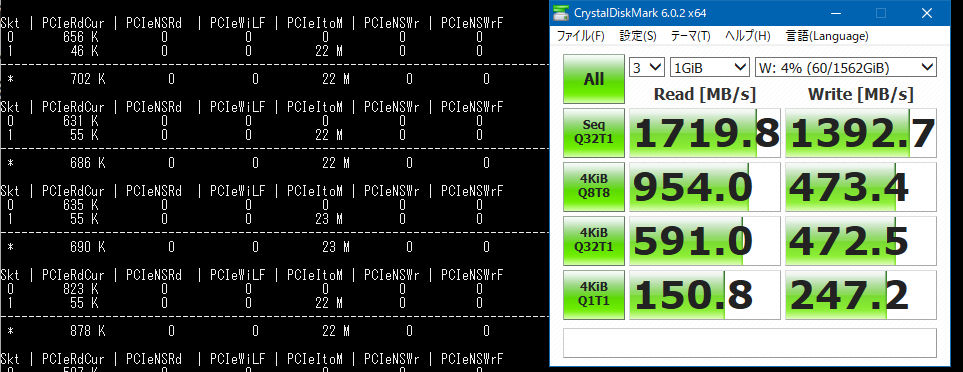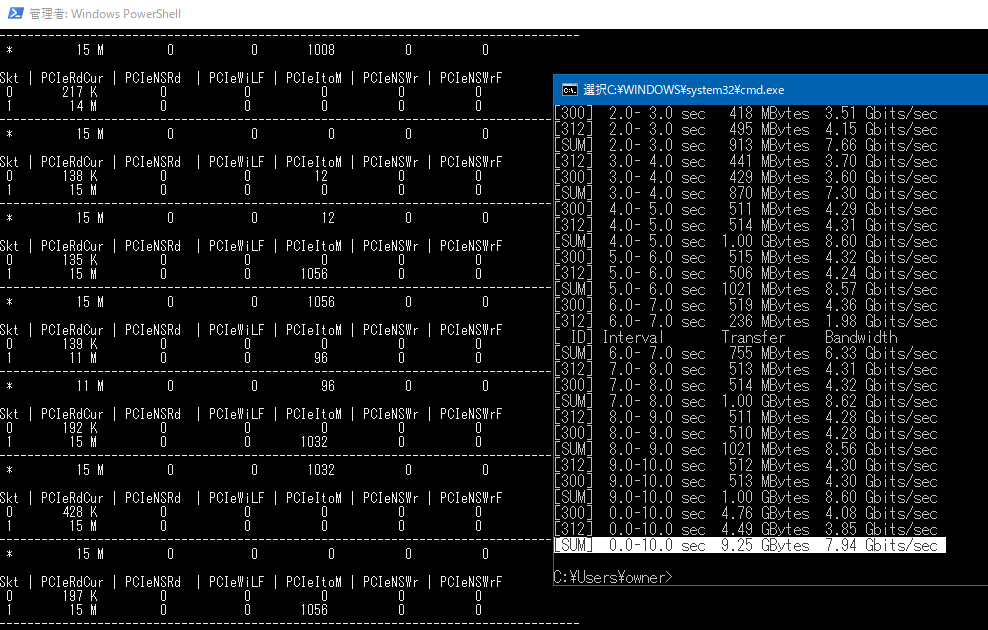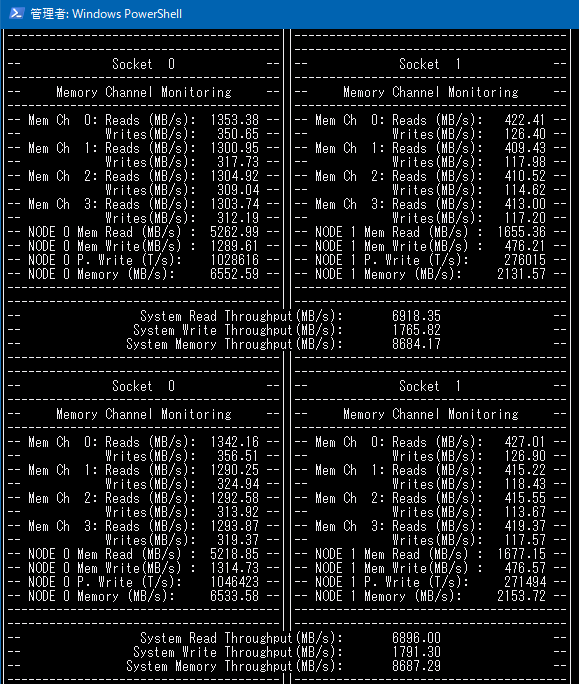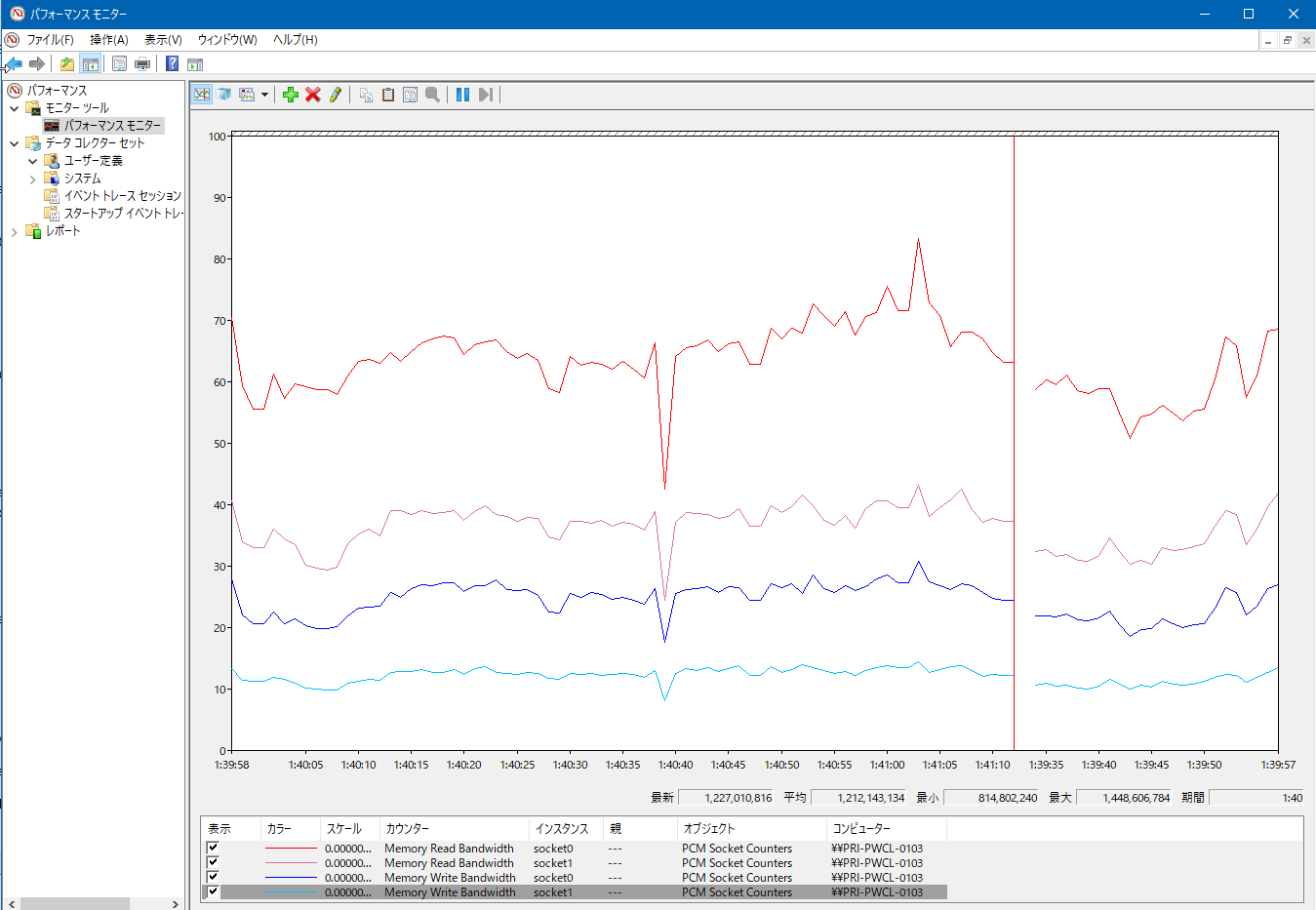そのかわり、IntelからPCM Toolsというものがリリースされていて、これを使うとパフォーマンスカウンタでは見えない部分を見ることができます。ただし、プレビルドのものは配布されていないので自分でコンパイルする必要があります。
最初はVS2019でコンパイルしようとしたのですがthr/xthreadが存在しないためincludeできないと言われうまく行かず(たしかに探しても見つからない)、いろいろ試してもVS知識がなくてわからず、結局VS2017でコンパイルしたらうまくいきました。
自分用のメモとしてビルドのものを置いておきます。
PCM_201902 release.zip
ビルドするとpcm_*.exeという実行ファイルがいくつかできるのですが、有用だったのでいくつか紹介してみます。
PCI-Eの使用状況がわかるpcm-pcie
pcm-pcie.exeを実行すると以下のような出力があります。
.\pcm-pcie.exe
DEBUG: Setting Ctrl+C done.
Processor Counter Monitor: PCIe Bandwidth Monitoring Utility
This utility measures PCIe bandwidth in real-time
PCIe event definitions (each event counts as a transfer):
PCIe read events (PCI devices reading from memory - application writes to disk/network/PCIe device):
PCIePRd - PCIe UC read transfer (partial cache line)
PCIeRdCur* - PCIe read current transfer (full cache line)
On Haswell Server PCIeRdCur counts both full/partial cache lines
RFO* - Demand Data RFO
CRd* - Demand Code Read
DRd - Demand Data Read
PCIeNSWr - PCIe Non-snoop write transfer (partial cache line)
PCIe write events (PCI devices writing to memory - application reads from disk/network/PCIe device):
PCIeWiLF - PCIe Write transfer (non-allocating) (full cache line)
PCIeItoM - PCIe Write transfer (allocating) (full cache line)
PCIeNSWr - PCIe Non-snoop write transfer (partial cache line)
PCIeNSWrF - PCIe Non-snoop write transfer (full cache line)
ItoM - PCIe write full cache line
RFO - PCIe partial Write
CPU MMIO events (CPU reading/writing to PCIe devices):
PRd - MMIO Read [Haswell Server only] (Partial Cache Line)
WiL - MMIO Write (Full/Partial)
* - NOTE: Depending on the configuration of your BIOS, this tool may report '0' if the message
has not been selected.
Starting MSR service failed with error 2 Trying to load winring0.dll/winring0.sys driver...
Using winring0.dll/winring0.sys driver.
IBRS and IBPB supported : yes
STIBP supported : yes
Spec arch caps supported : no
Number of physical cores: 16
Number of logical cores: 32
Number of online logical cores: 32
Threads (logical cores) per physical core: 2
Num sockets: 2
Physical cores per socket: 8
Core PMU (perfmon) version: 3
Number of core PMU generic (programmable) counters: 4
Width of generic (programmable) counters: 48 bits
Number of core PMU fixed counters: 3
Width of fixed counters: 48 bits
Nominal core frequency: 3300000000 Hz
IBRS enabled in the kernel : no
STIBP enabled in the kernel : yes
Package thermal spec power: 130 Watt; Package minimum power: 68 Watt; Package maximum power: 200 Watt;
ERROR: QPI LL monitoring device (0:7f:8:2) is missing. The QPI statistics will be incomplete or missing.
ERROR: QPI LL monitoring device (0:7f:9:2) is missing. The QPI statistics will be incomplete or missing.
Socket 0: 1 memory controllers detected with total number of 4 channels. 0 QPI ports detected. 0 M2M (mesh to memory) blocks detected.
ERROR: QPI LL monitoring device (0:ff:8:2) is missing. The QPI statistics will be incomplete or missing.
ERROR: QPI LL monitoring device (0:ff:9:2) is missing. The QPI statistics will be incomplete or missing.
Socket 1: 1 memory controllers detected with total number of 4 channels. 0 QPI ports detected. 0 M2M (mesh to memory) blocks detected.
Detected Intel(R) Xeon(R) CPU E5-2667 v2 @ 3.30GHz "Intel(r) microarchitecture codename Ivy Bridge-EP/EN/EX/Ivytown" stepping 4 microcode level 0x42c
Update every 1 seconds
delay_ms: 54
Skt | PCIeRdCur | PCIeNSRd | PCIeWiLF | PCIeItoM | PCIeNSWr | PCIeNSWrF
0 507 K 0 0 0 0 0
1 168 0 0 1080 0 0
-----------------------------------------------------------------------------------
* 507 K 0 0 1080 0 0
Skt | PCIeRdCur | PCIeNSRd | PCIeWiLF | PCIeItoM | PCIeNSWr | PCIeNSWrF
0 501 K 0 0 0 0 0
1 552 0 0 12 0 0
-----------------------------------------------------------------------------------
* 501 K 0 0 12 0 0
....
最初は各値が何を意味しているのかわかりませんでしたが、よく見ると実行すると最初に出力されるところに意味が書いてありました。気にするべきは PCIeRdCurとPCIeItoMで、PCIeRdCurはPCIE→ CPU/メインメモリへの読み取り(ホスト側から見て書き込み)で、 PCIeItoMはPCIE→CPU/メインメモリへの書き込み(ホスト側から見て読み込み)のようです。
例として、ソケット2配下のPCIEに接続されているnvme(U.2フォームファクタ)へのベンチマーク中にとった値は、CDMの読み込みで1719MB/sと出ましたがPCMの方では23Mとなりました。

この23Mというのが何を意味しているかというと、1秒間に23M回要求があったということらしいです。これらからI/Oのサイズを求めると (1719.8 MB/s) / 23MHz となり、IOサイズは約74バイトという計算になります(計算はグーグル先生におまかせ)。
いろいろ調べると、PCI-EのパケットサイズはボードのTransaction Layer Packet (TLP)宣言によって16から4094バイト(2^4 -2^12) で送信できるらしいのですが、そうなると微妙に合いません。
逆に1719MB/sを64バイトで達成するには一秒間あたり26MHzの要求が必要になり、これもまた微妙に合いません。謎ですが、多分サンプリング間隔やCDMの帯域集計などのズレが有るのでしょう…。
また、別のケースとして(これも余ったから)使用している10GカードのConnectX2-ENから別の物理マシンへiperfしたところ、 8.25 GBytes (7.08 Gbits/sec)の速度が出たのですが、この際のpcm-pcieの値は以下のようでした。

これに64バイトをかけると15MHz*64Byte=7680 Mbpsとなり、やはり近い値が出ているようです。
X9DAiのマニュアルによると、パケットサイズを256byte、ReadReqデータサイズは4kまで拡大できるらしいのですが、これを拡張しても特に要求回数が減ることはなかったので謎です。Linuxではlspciコマンドをvvvなどで実行すると出てくるDevCapがカード自体のケーパビリティ、DevCtlが実際にネゴシエートしている値として取得できるのですが、Windows上ではどのように動いているか不明です。逆にLinux上では64バイトという値はなかったので本当にこの計算があっているのか不安です…。
参考:
https://community.mellanox.com/s/article/understanding-pcie-configuration-for-maximum-performance#jive_content_id_PCIe_Max_Payload_Size
ちなみに、この確認の中で知ったのですが、X9DAiは各スロットでx16をx4x4x4x4などへ分割するPCIE Bifurcationに対応していたので、x16スロットにASUSのULTRA QUAD M.2 CARDのようなPLXのスイッチングチップを持たないnvme4枚刺しのカードを刺しても使えるようです。おそらくもともとはライザーカード対応のための機能だと思いますが…。
使用中のメモリ帯域がわかるpcm-memory.exe
このプログラムはなかなか有用で、チャンネルごとのメモリ帯域がわかります。

メモリ帯域のベンチマークを回すとシングルスレッドで12GB/s、4チャンネルあるのでマルチスレッドでコアあたり48GB/s、ソケット合計88GB/sという速度が出ましたが、ゲームをやっている限りせいぜい7-9GB/s程度の要求だったのでメモリ帯域についてはまだボトルネックではないということがわかりました。
メモリ帯域などをパフォーマンスモニターで見られるPCM-Service.exe
pcm-memory.exeをパフォーマンスモニターのグラフで見るためのサービスです。管理者権限でPCM-Service.exe -InstallでインストールするとProcessor Counter Monitor Serviceというサービスが追加され、これを開始するとパフォーマンスカウンターにPCM_*が追加されます。

これらのパフォーマンスモニタリングから、最終的な結論としてXeon E5 2667v2は足回りはまだ余裕があるもののコアあたりの性能をあげないとゲームにおいてより良いパフォーマンスを得られないということがわかりました。感覚的にわかっていましたが…。
ただ、Zen2やCore i7系のCPUだと、使っているインターフェースカード的にPCIEのレーン数が足りないので、その点QPI跨いでしまってもレーン数の多いE5系は使いやすいんですよね…。
レガシーハードウェアが多いのでPCIE4.0を3.0にダウングレードしてそのかわりレーン数を倍にするスイッチングチップなどがあると嬉しいのですが、そんなニッチなものが売れるとは思えないですし、コスト的にも割に合わないと思うので厳しいです。Xeon Wシリーズがほしいのですが高い…。
人間は迷うと現状維持を選ぶらしいですが、今回もそうなりそうです。
ツイート
Cheap NFL Jerseys
NFL Shop Official Online Store
Official NFL Jersey
NFL Gear
Cheap NFL Jerseys
Cheap Jerseys
Best NFL Jerseys
Cheap NHL Jerseys Reddit
Wholesale Jerseys
Cheap Jerseys
NFL Store
NHL Store
NBA Store Online
NBA Jerseys
NHL Jerseys
Football Jerseys
Jerseys Cheap
NBA Shop
Cheap Jerseys From China
NFL Team Shop
Cheap Jerseys
New NBA Jerseys
MLB Jerseys China
NBA Clothing
MLB Jerseys
NFL Gear
MLB Jerseys China
Football Jerseys
Jerseys Wholesale
Jerseys Wholesale
MLB Official Site
NHL Jerseys Cheap
Cheap NFL Jerseys
Baseball Jerseys
MLB Jerseys China
Wholesale Jerseys
Cheap Football Jerseys
Cheap NBA Jerseys
NHL Jerseys
NFL Pro Shop
Cheap Jerseys From China
Cheap Jerseys From China
Cheap NBA Jerseys From China
NFL Shop Official Online Store
Cheap Jerseys
NHL Jerseys Cheap
Wholesale Jerseys
NFL Jerseys
Cheap NFL Jerseys From China
NHL Jerseys Cheap
Jerseys Wholesale
Cheap MLB Jerseys From China
NFL Football Jerseys
NFL Jerseys
NFL Store
Cheap China Jerseys Wholesale
NFL Shop
MLB Shop
Custom Baseball Jerseys
NFL Jerseys Cheap
Custom MLB Jerseys
NFL Jerseys
MLB Jerseys
NBA Jerseys
NFL Store
NFL Jersey Sales
Cheap NHL Hockey Jerseys
NFL Jerseys Cheap
Cheap NFL Jerseys
Cheap MLB Jerseys
NFL Jerseys China
Cheap Jerseys
MLB Jerseys Wholesale
Cheap Jerseys From China
Football Jerseys
NFL Store
NFL Fan Shop
Wholesale Jerseys China
コメントを書く
必要事項とコメントを入力して下さい。